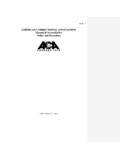Transcription of International Classification of Impairments, Disabilities ...
1 International Classification of Impairments, Disabilities , and Handicaps A manual of Classification relating to the consequences of disease Published in accordance with resolution WHA29. 35 of the Twenty-ninth world health Assembly, May 1976 ., world health organization GENEVA 1980 The world health organization is a specialized agency of the United Nations with primary responsibility for International health matters and public health . Through this organization ~ which was created in 1948~ the health professions of some 180 countries exchange their knowledge and experience with the aim of making possible the attainment by all citizens of the world by the year 2000 of a level of health that will permit them to lead a socially and economically productive life.
2 By means of direct technical cooperation with its Member States, and by stimu-lating such cooperation among them, WHO promotes the development of compre-hensive heaJth services, the prevention and control of diseases, the improvement of environmental conditions, the development of human resources for health , the coor-dination and development of biomedical and health services research~ and the plan-ning and implementation of health programmes. These broad fields of endeavour encompass a wide variety of activities, such as developing systems of primary health care that reach the whole popUlation of Mem-ber countries; promoting the health of mothers and children; combating malnutrition; controlling malaria and other communicable diseases including tuberculosis and leprosy; coordinating the global strategy for the prevention and control of AIDS; having achieved the eradication of smallpox, promoting mass immunization against a number of other preventable diseases; improving mental health ; providing safe water supplies.
3 And training health personnel of all categories. Progress towards better health throughout the world also demands International cooperation in such matters as establishing International standards for biological substances, pesticides, and phannaceuticals; fonnulating environmental health cri-teria; recommending International nonproprietary names for drugs; administering the International health Regulations; revising the International Statistical Classifica-tion of Diseases and Related health Problems; and collecting and disseminating health statistical information. Reflecting the concerns and priorities of the organization and its Member States, WHO publications provide aUlhoritative infonnation and guidance aimed at pro-moting and protecting health and preventing and controlling disease.
4 Reprinted 1985, 1989, 1993 (with foreword) ISBN 924154126 I world health organization 1980 Publications of the world health organization enjoy copyright protection in accordance with the provisions of Protocol 2 of the Universal Copyright Convention. For rights of reproduction or translation of WHO publications, .in part or in tolo. application should be made to the Office of Publications~ world health organization , Geneva, Switzerland. The world health organization welcomes such applications. The designations employed and the presentation of the material in this publication do not imply the expression of any opinion whatsoever on the part of the Secretariat of the world health organization concerning the legal status of any country~ territory, city or area or of its authorities, or concerning the delimitation of its frontiers or boundaries.
5 The mention of specific companies or of certain manufacturers' products does not imply that they are endorsed or recommended by the world health organization in preference to others of a similar nature that arc not mentioned. Errors and omissions excepted, the names of proprietary products are distinguished by initial capital letters. PRINTED IN SWITZERLAND 79/4624 Schillcr 8000 84/6287 -SchUlcr 2000 (R) 89/8176 Schiiler 1500 (R) 92/9504 Schfiler 1000 (R) CONTENTS Page Foreword to the 1993 reprint .. 1 Introduction .. 7 Section 1 THE CONSEQUENCES OF DISEASE The response to illness .. 23 A unifying framework .. 25 Application of the concepts.
6 31 Section 2 Classification OF IMPAIRMENTS Definition and characteristics .. 47 List of two-digit categories .. 48 1 Intellectual impairments .. 53 2 Other psychological impairments.. 57 3 Language impairments .. 68 4 Aural impairments .. 73 5 Ocular impairments .. 79 6 Visceral impairments .. 86 7 Skeletal impairments .. 92 8 Disfiguring impairments .. 106 9 Generalized, sensory, and other impairments .. 112 Guidance on assignment .. 11 7 .. 121 Section 3 Classification OF Disabilities Definition and characteristics .. 143 List of two-digit categories .. 144 1 Behaviour Disabilities .. 148 2 Communication Disabilities .
7 153 3 Personal care Disabilities .. 157 4 Locomotor Disabilities .. 161 5 Body disposition Disabilities .. 163 6 Dexterity Disabilities .. 166 7 Situational Disabilities .. 168 8 Particular skin Disabilities .. 1 71 9 Other activity restrictions .. 172 IV CONTENTS Page Supplementary gradings of disability .. 173 Guidance on assignment .. 179 Section 4 Classification OF HANDICAPS Definition and characteristics .. 183 List of dimensions .. 184 Orientation handicap .. 185 2 Physica1 independence handicap.. 188 3 Mobility handicap .. 192 4 Occupation handicap .. 195 5 Social integration handicap .. 199 6 Economic self-sufficiency handicap.
8 202 7 Other handicaps .. 206 Guidance on assessment .. 207 FOREWORD TO THE 1993 REPRINT The International C/rlssification of Impairments, Disabilities . and Handicaps (ICIDH), developed in the 1970s, was issued by the world health organization in 1980 as a tool for the Classification of the consequences of disease (as well as of injuries and other disorders) and of their implications for the lives of individuals. It now exists in 13 languages I and further versions in other languages are in preparation; more than 15 000 copies of the English and French versions and over 10000 copies in other languages have been distri-buted.
9 The bibliography maintained by the WHO Collaborating Centre on ICIDH in the Netherlands lists over 1000 references to the ICIDH. Published comments on the ICIDH include such remarks as: "[The ICIDH] concepts provide the key to rational management of chronic diseases"; at the same time, however, concern has been expressed that the ICIDH does not state clearly enough the role of social and physical environment in the process of handicap} and that it might be construed as encouraging "the medicalization of disablement". (The term "disablement" is used here to encompass the full range of impainnent, disability, and handicap.)
10 The ICIDH belongs to the "family" of classifications developed by WHO for applica-tion to various aspects of health and disease. The best established is the International Statistical Classification of Diseases. Injuries, and Causes of Death (leD), the Ninth Revision of which (ICD-9) was issued shortly before the publication of the ICIDH. The first volume of the Tenth Revision of the ICD (lCD-IO), published in June 1992, includes various changes, for instance in the area of mental and behavioural disorders, which will have to be taken into account in a revised ICIDH. The dissemination and application of the ICIDH, as well as the advocacy role of organizations.
















